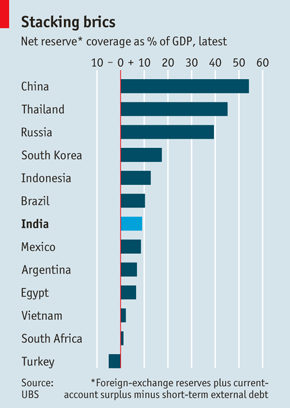Rupee logs biggest 1-day gain in more than 2-1/2 yrs - www.ddinews.com
Rupee logs biggest 1-day gain in more than 2-1/2 yrs
The rupee surged 1.4 percent on Thursday and posted its largest single-session rise since May 2009, powered by hopes of dollar inflows, a day after the world's six major central banks announced co-ordinated action to help ease the euro zone crisis.
Strong gains in local shares, mirroring global equities, and the euro's sharp climb buoyed the rupee, traders said.
Robust interest from foreign investors at the debt limit auction on Wednesday added to the sanguine outlook on dollar inflows and boosted the local currency, they said.
The enhanced $10 billion debt limit for foreign institutional investors (FIIs) received bids worth $14 billion, four market sources said on Wednesday.
The partially convertible rupee ended at 51.46/47 per dollar, after gaining as much as 51.40 -- a level last seen on November 18 -- in early trade. It had closed at 52.20/21 on Wednesday.
The local currency had last witnessed such a sharp rise on May 18, 2009, when it climbed more than 3 percent on the back of a 17-percent surge in local equities, after the re-election of the Congress party-led ruling coalition.
The U.S. Federal Reserve, the European Central Bank and the central banks of Canada, Britain, Japan and Switzerland said on Wednesday they would lower the cost of existing dollar swap lines by 50 basis points from December 5, and arrange bilateral swaps to provide liquidity for other currencies.
RUPEE STILL VULNERABLE
Despite the rupee's strong performance on Thursday, the local currency was still open to a correction, traders said.
"After Wednesday, market is hoping for bigger and better things from ECB and European policy makers to help the euro zone out of the debt crisis," said Priyanka Kishore, forex strategist at Standard Chartered Bank.
"But portfolio flows are unlikely to be a one-way bet, until more concrete progress is made on solving the euro zone crisis. So rupee remains vulnerable to bouts of risk aversion."
Foreign funds are still net sellers this year of $527 million of local shares as of Tuesday, compared with a record investments of more than $29 billion in 2010.
The rupee had declined 6.7 percent in November and is the worst performer among Asian peers this year.
Traders said gains in the euro too were expected to be limited ahead of next week's summit of European Union leaders and could cap the rupee's rise.
"Euro still looks vulnerable and the dollar inflow has to materialise for the rupee to see continued rise. Domestic factors like trade deficit, slowing growth, remain negative," said a senior forex dealer with a private-sector bank.
The euro was at $1.3473 at end of rupee trade, while the index of the dollar against six major currencies was at 78.276 points.
The one-month offshore non-deliverable forward contracts were quoted at 51.76.
The one-month onshore forward dollar premium was at 27.75 points from 28.75 on Wednesday, the three-month was at 67.25 points from 64, and the one-year premium was at 186.50 points, from 165.25.
In the currency futures market, the most traded near-month dollar-rupee contracts on the National Stock Exchange ended at 51.70, while on the United Stock Exchange and the MCX-SX they both ended at 51.71. The total volume at $5.08 billion.(BJ-1/12)






